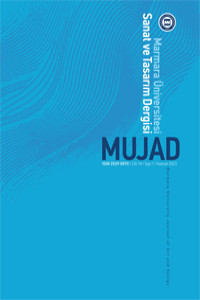Abstract
Tasarım karmaşık ve çok boyutlu bir aktivitedir ve özellikle tasarım pratikleri içerisinde yaygın olarak; yorumlama, iletişim, problem çerçeveleme, araştırma ve bilgi entegrasyonu gibi çeşitli beceri ve eğilimleri içerdiği, karmaşık ve çok boyutlu bir aktivite olduğu kabul edilir. Tasarım temel olarak zihinsel, temsili ve insan zekasının bir göstergesidir ve tipik bir bilişsel süreç olarak ele alınır. Bu çalışma öncelikle bilişsel bir süreç olarak kabul edilen tasarımın bilim ile ilişkili olarak nasıl incelendiğini araştırmaktadır ve bilim ve tasarım perspektifinden bakıldığında bilişsel bilim ile tasarım bilişinin kesişimlerini ortaya koymaktadır. İkinci olarak literatürün yorumlanması ile açığa çıkan tasarım sürecinin günümüzde yaratıcı oluş üzerinden ele alınarak nasıl değerlendirildiğini örneklendirmektedir. Çalışma; günümüzde tasarım bilişi ile ilgili araştırmaların yaratıcılığı merkez noktası alan çok yönlü bir bakışa ihtiyaç duymakta olduğunu göstermiştir.
Keywords
Supporting Institution
yok
Project Number
yok
Thanks
yok
References
- Bermúdez, J. L. (2014). Cognitive Science: An Introduction to the science of the mind. New York: Cambridge University Press.
- Bonnardel, N. (2000). Towards understanding and supporting creativity in design: analogies in a constrained cognitive environment. Knowledge-Based Systems, 13 (7-8), 505-513.
- Brawne, M. (2003). Architectural thought: the design process and the expectant eye. Architectural Press.
- Buchanan, R. (1992). Wicked problems in design thinking. Design Issues, 8(2), 5-21.
- Cross, N. (1993). A history of design methodology. In de Vries, M.J., Cross, N., Grant, D.P. (Eds), Design Methodology and Relationships with Science (pp. 15-27). NATO ASI Series, vol 71. Springer, Dordrecht. https://doi.org/10.1007/978-94-015-8220-9_2
- Cross, N. (1999). Natural intelligence in design. Design Studies, 20(1), 25-39. https://doi.org/10.1016/S0142-694X(98)00026-X
- Cross, N. (2001). Designerly ways of knowing: Design discipline versus design Science. Design Issues, 17(3), 49-55.
- Cross, N. (2006). Designerly Ways of Knowing (pp. 1-13). Springer. http://dx.doi.org/10.1007/1-84628-301-9
- Eastman, C. (2001). New directions in design cognition: studies of representation and recall. In Eastman, Charles M., W. Michael McCracken&Wendy C. Newstetter Design knowing and learning: Cognition in design education (pp. 147-198). Elsevier.
- Freedberg, D., & Gallese, V. (2011). Motion, emotion and empathy in esthetic experience. In M. F. Gage, Aesthetic theory: Essential texts for architecture and design (pp. 309-323). W.W.Norton&Company.
- Gardner, H. (1985). The mind's new science: A history of the cognitive revolution. Basic Books Inc. Publishers.
- Goel, V., & Pirolli, P. (1992). The structure of design problem Spaces. Cognitive Science, 16(3), 395-429.
- Kahvecioğlu, N. P. (2007). Architectural design studio organization and creativity. ITU A|Z, 4(2), 6-26.
- Kirby, M. (1969). The aesthetics of the avant-garde. The art of time (pp. 35-64). Dutton.
- Oxford University Press. (n.d.). Internet addiction. In Oxford English Dictionary. Retrieved March 20,2023, from https://www.oxfordlearnersdictionaries.com/definition/academic/design1?q=design
- Plowright, P. D. (2014). Revealing architectural design: Methods, frameworks and tools. Routledge.
- Shapiro, L. (2011). Embodied cognition. Routledge.
- Suwa, M., Gero, J., & Purcell, T. (2000). Unexpected discoveries and s-inventions of design requirements: Important vehicles for a design process. Design Studies, 21(6), 539-567.
- Takala, T. (1993). A neuropsychologically-based approach to creativity. In J. S. Gero, & M. L. Maher, Modeling, creativity and knowledge-based creative design (pp. 91-108). Lawrence Erbaum Associates.
- Türk Dil Kurumu (TDK). Internet addiction. In Türk Dil Kurumu Sözlükleri. Retrieved March 30, 2023, from https://sozluk.gov.tr/
- Vermaas, P.E., 2014. Design theories, models and their testing: on the scientific status of design research. In: A. Chakrabarti and L.T.M. Blessing, (Eds.), An anthology of theories and models of design: Philosophy, approaches and empirical explorations (pp. 47-66). Springer.
- Thagard, P. (2008). Cognitive science [Internet]. Stanford Encyclopedia of Philosophy. Retrieved March 29, 2023, from https://plato.stanford.edu/entries/cognitive-science.
Details
| Primary Language | Turkish |
|---|---|
| Subjects | Design History, Theory and Criticism |
| Journal Section | Review Articles |
| Authors | |
| Project Number | yok |
| Early Pub Date | June 26, 2023 |
| Publication Date | June 27, 2023 |
| Published in Issue | Year 2023 Volume: 14 Issue: 1 |

